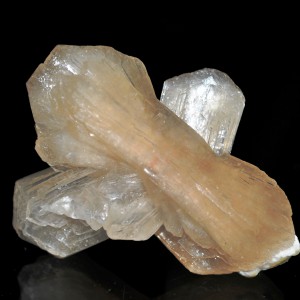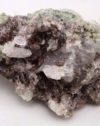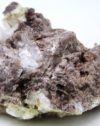HISTORY, NAME, LOCALITIES: Stilbite was recognized as a species in 1822. Its name stems from the Greek stilbein, meaning “to glitter,” alluding to its vitreous luster. The “Ca” suffix denotes it as the calcium-rich member of the stilbite-mineral group. Stilbite-Ca is collected in India, Iceland, Denmark’s Faeroe Islands, England, Russia, and the United States (Idaho, Nevada, New Jersey, Connecticut).
MINERALOGY, PROPERTIES, OCCURRENCE: Stilbite-Ca [hydrous calcium potassium sodium aluminum silicate, (Ca0.5,K,Na)9(Al9Si27O72)•28H2O], pronounced STILL-bite (cee-ay), crystallizes in the monoclinic system as prismatic aggregates of numerous twinned crystals that are often pinched in the middle to resemble bow ties. It has a Mohs hardness of 3.5-4.0, vitreous luster, perfect cleavage in one direction, and a specific gravity of 2.1-2.2. Stilbite is usually colorless, but impurities can impart a range of pale colors. As a zeolite, stilbite can lose or regain its attached water of hydration without altering its crystal structure. Stilbite-Ca is a secondary mineral that forms in vugs in basaltic rock in association with other zeolites, and also occurs in sedimentary layers that have undergone alkaline alteration.
METAPHYSICAL PROPERTIES, LORE, USES: Stilbite-Ca was once thought to counteract poisons. According to modern metaphysical belief, stilbite heals the soul, enhances intuition, and promotes restful sleep and vivid dreaming. Stilbite is mined from sedimentary deposits along with other zeolite minerals and used in laundry detergents, water and gas filters, and agricultural soil conditioners.
COLLECTORS’ INFORMATION: Among the most collectible of all zeolite minerals, stilbite-Ca is valued for its unusual crystal form and interesting associations with other zeolites.





 Axinite #10
Axinite #10  Axinite #8
Axinite #8